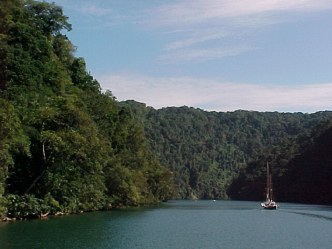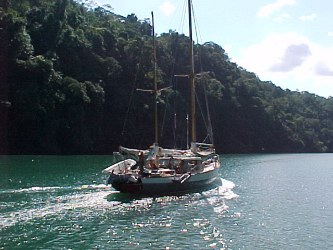The Cruising Adventures of Joan & Ben Schuetz aboard | home
Part 9: Return to a trap
First, let me say that the malaria is all cleared up and I have had no further episodes. The high dose Chloroquine kept me awake at night (I think), but other than that, there were no other known side affects. (Whew!) I forgot to tell about this and have had a few concerned email inquiries.
Cruisers refer to great, secure, easy living places as traps. Wonderful places to stay for a long time and hard to leave. Today, we are at the dock at Mario's Marina near Fronteras, Guatemala. Before we arrived in the Rio, I had forgotten just how wonderful this place is. The greens are greener, the people friendlier, the food is better, . . . so many superlatives. But, I'm getting ahead of the story.
While we were at anchor near the Sarstoon River, some fishermen paddled out to Awab and sold a few pounds of shrimp. As shrimp prices go, there weren't all that inexpensive. But, not so expensive when considering that each shrimp had to be caught individually with a cast net. It may have taken them all day to catch what we bought. They were excellent. That night, a gentle easterly breeze rolled Francesca just enough to be pleasantly relaxing.
In the morning, it took only about one and a half hours to reach Livingston and the mouth of the Rio Dulce. The bar at the mouth of the river is large covering several square miles. In several places it is less than 6 feet deep. With only a four foot draft, Francesca had no problem crossing the bar, but Awab had to be on tip toes to get across. Livingston is a neat little town of, I'm guessing, 5 to 6000 people. There are two banks, a dozen or so restaurants/bars/hotels, a luxury hotel, paved streets, and very pleasant people. While the town has quite a number of vehicles, there are no roads to the town. There is a fleet of small boats to ferry people to other places like Puerto Barrios and Fronteras.
About an hour after anchoring, the Port Captain, Immigrations Officer, and Customs Officer boarded our two boats. They filled out some paperwork and said that we should be at their offices after about one half hour. They were refreshingly nice and smilingly welcomed us to Guatemala. The check-in process took a couple hours. First, a visit to Customs (Aduana), then pay at the bank, back to Customs and pay another small fee, then to the Port Captains office and a fee, and finally to the Immigration office and another fee. Altogether, the fees came to about $65, but that covered everything for up to three months. These fees have been standard for a long time and no tips are necessary.
By about 1:30 PM, we were back at our boats and ready to go up river. This is where, even after having done this four times before, I am still awestruck by the loveliness of the gorge. It is large, not huge, yet all but small limestone cliff areas are covered with the deepest green imaginable. Most of the river in the gorge is 30 to 75 feet deep and mostly clear, but with a clean greenest coloration. Tarzan's vines hang down often a hundred feet or more while egrets, ibis, pelicans, cormorants, hawks and herons dot the cliff foliage. On the river, indians in cayucas, (dugout canoes), are constantly on the move, fishing, casting nets, or visiting friends. As I have reported in the past, 5 year old and older children are alone on the river as a matter of routine. Since there are no roads nearby, outboard motored pangas are constantly on the move, ferrying people up and down river both day and night.


We anchored near Ak' Tenemit for the night. Ak' Tenemit is a kind of cultural center for the local Mayans. It is a social center, school, clinic and probably has a lot of other uses of which we are unaware. This we know, the children paddle to school or are ferried in 30 foot long pangas, holding about 75 people each, (Life jackets? Are you kidding?). People are coming and going from Ak' Tenemit constantly.
In the morning, we motored across El Golfette (lake) to Fronteras, where we found dockage at Mario's Marina. Mario's has a couple dozen sailboats med-moored (one end tied to the dock, the other tied to a mooring off shore). But they also had a long dock with room for about 6 boats. Awab and Francesca were lucky enough to get the last two spots on the dock. In a few minutes we had met several other boat owners and immersed ourselves into story telling. Now, and until we leave this tropical delight, we will have a very different lifestyle. The last time we were here, Mario's was a popular marina, but we did not come here often because the management would not allow us to bring Maggie into the restaurant area. But, Mario's is now under new, friendlier management. Maggie is welcome and they, Joann and Brian, are super nice. Our dockage during low season is $150 per month plus electricity. The grounds are kept beautifully and there is every amenity. Lunch at Mario's open air palapa bar and restaurant was excellent and very reasonable.
We stopped off at Los Brisas el Golfette (the breezes of Golfette), the indian village where Maria and Norm spend most of their time. But they had gone to Guatemala (the locals say Guatemala or the city for Guatemala City, never both). They were to be back the next day. We are anxious to see Maria and Norm and to spend a little time in the village. Joan's sister, Sue, has sent quite a load of stuff along for the village. We also have food, paper products, and such for them. I know they will be glad to have it.
This morning, Joan and I went across the river to the Yamaha dealer because our outboard propeller spun (inner core was loose) and we couldn't run the dinghy very fast. They had a new prop for us and within minutes we were zipping about again. Then, another short trip on the river and we were at Fronteras. After a leisure walk down the main street, Joan had picked up a dozen bananas, a huge cabbage, a dozen tomatoes, some nice onions, cilantro, a watermelon and some bread. All together it was less than $4.00. Then we had breakfast at a roadside/outside eatery. Two huevos rancheros (eggs with salsa on tortillas and black beans) for $1.50 total. The trouble with this place is that after a month or two, you are so used to the easy life that it is hard to imagine that there was any other. In a way, it's too easy and one has to be creative and make an effort to be active.
At this moment, we don't have any plans to do inland travel. We have seen most of Guatemala before. But, who knows? Our plans are etched in Jello and for now, color us mellow.
There may not be another newsletter for a couple of weeks. How does one make leisure living interesting to others?
Joan, Ben & Maggie

